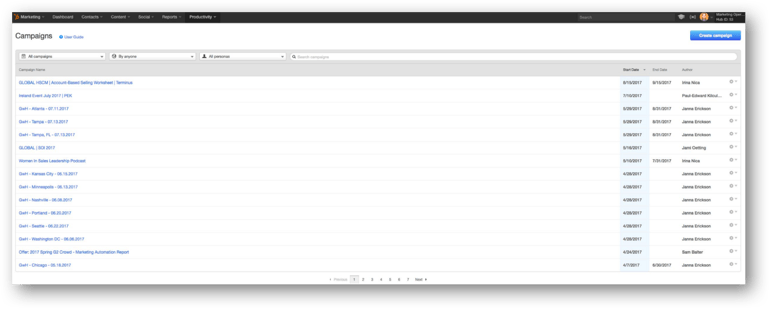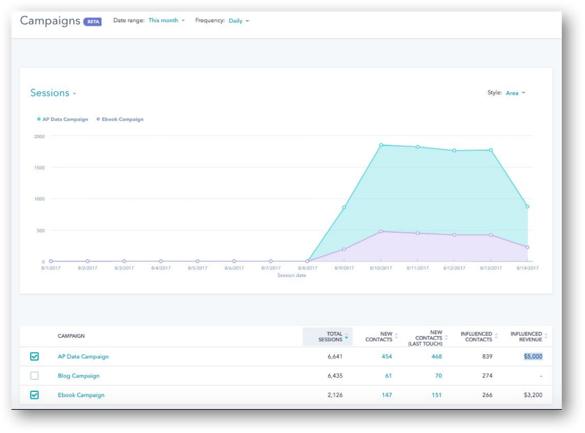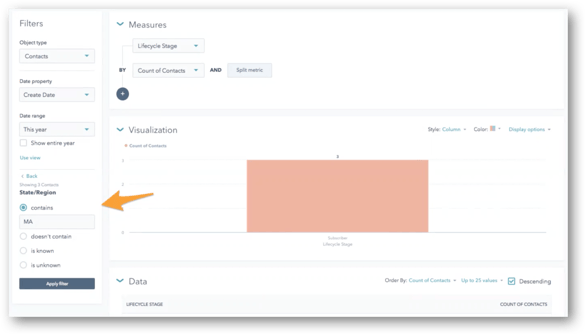When it comes to reporting on your Inbound Marketing efforts through HubSpot, we understand just how complex the process can be.
While HubSpot is an amazing tool that offers a diverse array of features, there’s so much detail being provided at every level. There are so many metrics, tools and reports that you can use alongside sophisticated analytics - and it can be tempting to delve into each one individually. But, as a direct result, you can suffer from paralysis by analysis and you quickly lose sight of what it is you actually need to report on to understand the value of your marketing activity.
At Huble Digital, we have a code which we try to follow, which is: ‘don’t report for the sake of reporting’, meaning we only ever report on the stuff that matters.
After all, who cares if you got a 300% rise in Twitter impressions if your new leads generated was down by 35%?
As a Marketing Manager or Director, we know that you are under constant pressure from your CEO, stakeholders and Board to demonstrate the ROI of your Inbound Marketing activity. You need to be able to clearly convey the impact your marketing is having on the business’ bottom line, and your management team wants a convincing story about what revenue and what investment has been generated via your Inbound efforts.
Firstly, how do you currently generate ROI reports via your HubSpot portal - and what are you reporting on?
We’re going to guess that - if you are reporting - you’re doing one of the following:
-
Getting your HubSpot Partner to do it for you
-
Only exporting data on email data and opens and clicks
-
You’re using lots of annoying Excel data and creating PowerPoints
-
You’re using a custom third-party tool like DataHero or Klipfolio
OR you’re looking for help to:
-
Get started with ROI reporting and generate reports
-
Understand how you should go about the process and what to report on
-
Streamline your current reporting process so it's straightforward
However, you are in luck when it comes to reporting.
HubSpot have made three main changes to their reporting and analytics tools, making it easier for you to report on a day-to-day basis.
Revamped Campaign Reporting in Hubspot
HubSpot’s current campaigns tool allows you to tie together social posts, landing pages, blogs other pieces of marketing activity to a single campaign. While it’s great for managing and organising campaigns, when it comes to comparing the ROI of each campaign it’s difficult.
To resolve this, HubSpot have created a new campaign reporting dashboard. You simply create your content (e.g. landing page, blogs, social messages) and associate them all with a campaign as you usually would and let the reports run in the background.
Before the update, campaign reporting looked like this:

Now, it looks like this:

As you can see, you can now compare campaigns against each other, enabling you to get a clear view of the ROI of each campaign. You can choose specific campaigns you want to look at over a custom date range and filter results with criteria, including:
-
Total sessions - how many website sessions your campaign generated
-
New contacts generated (first touch) - new contacts generated (or converted) where their first touch was with an aspect of the campaign in question
-
New contacts generated (last touch) - new contacts generated (or converted) where their last touch was with an aspect of the campaign in question
-
Influenced contacts - how many existing contacts were influenced via this campaign
-
Influenced revenue - how much of your revenue was influenced via this campaign
We think this update is fantastic. It’s going to give you the ability to say to your CEO, stakeholders and/or Board: ‘with X campaign, we reached X amount of new visitors who turned into new contacts, and influenced X number of existing contacts in our database, which had £X influence on the business’ revenue’.
More reporting capabilities
The second update to the reporting and analytics within HubSpot is that there will now be more reporting features that come as standard with your HubSpot portal. At the moment, HubSpot has a set amount of reports you can use as part of your HubSpot licence, so if you want extended and customisable reporting, you have to pay for the additional reporting add on. However, this HubSpot update will provide extra value in the standard reporting tools, bringing more functions to a standard HubSpot portal.
-
Web analytics dashboard - a tool added by HubSpot earlier in the year, the web analytics dashboard provides a deep dive into your website’s analytics - providing information that you would have had to use Google Analytics for. From new visits to bounce rate, it will give you a good overview of how your website is performing.
-
Update campaign tool - as mentioned above, HubSpot have updated its campaign tool to allow comparative reporting across campaigns.
-
More pre-made reports - prior to the update, you could only access all of the pre-made reports via HubSpot’s reporting add on. However, with the update, these reports are now included with the standard HubSpot analytics, including deal stage funnels, MQLs by source, and some new company focused reports.
These reports are all now live and usable within your HubSpot portal.
More levers in report building
While some paid features in the reporting add on are going to be added to the standard HubSpot package, HubSpot is also revamping its pair for reporting add on to deliver more value to users, including:
-
Custom date ranges in one dashboard - previously if you had one dashboard with 10 different reports/graphs on them, you would have to choose one date range to be consistent through the dashboard, which restricted your ability to analyse. But what if you want custom date ranges for individual reports? For example, the way that you monitor your blog views might be different to the way you monitor leads generated. Similarly, your web traffic reporting might be different to how you report on your social activity. However, with HubSpot’s latest update, now you can. Not only do you have the ability to set a dashboard-wide date range, but also the ability to choose individual date ranges and assign them to specific reports.
-
Reporting filter {In Beta} - you can also now choose exactly which information you want to include in a specific report. What does that mean? Well for example if you want to show a graph of new contacts, but only those contacts that meet a specific criteria (e.g. certain landing pages), you can now filter in this way. You know the way when you’re segmenting contacts in HubSpot, you have the ability to filter on the left hand side by any information you have on them? Well you can now do the same within reporting.











.png)





